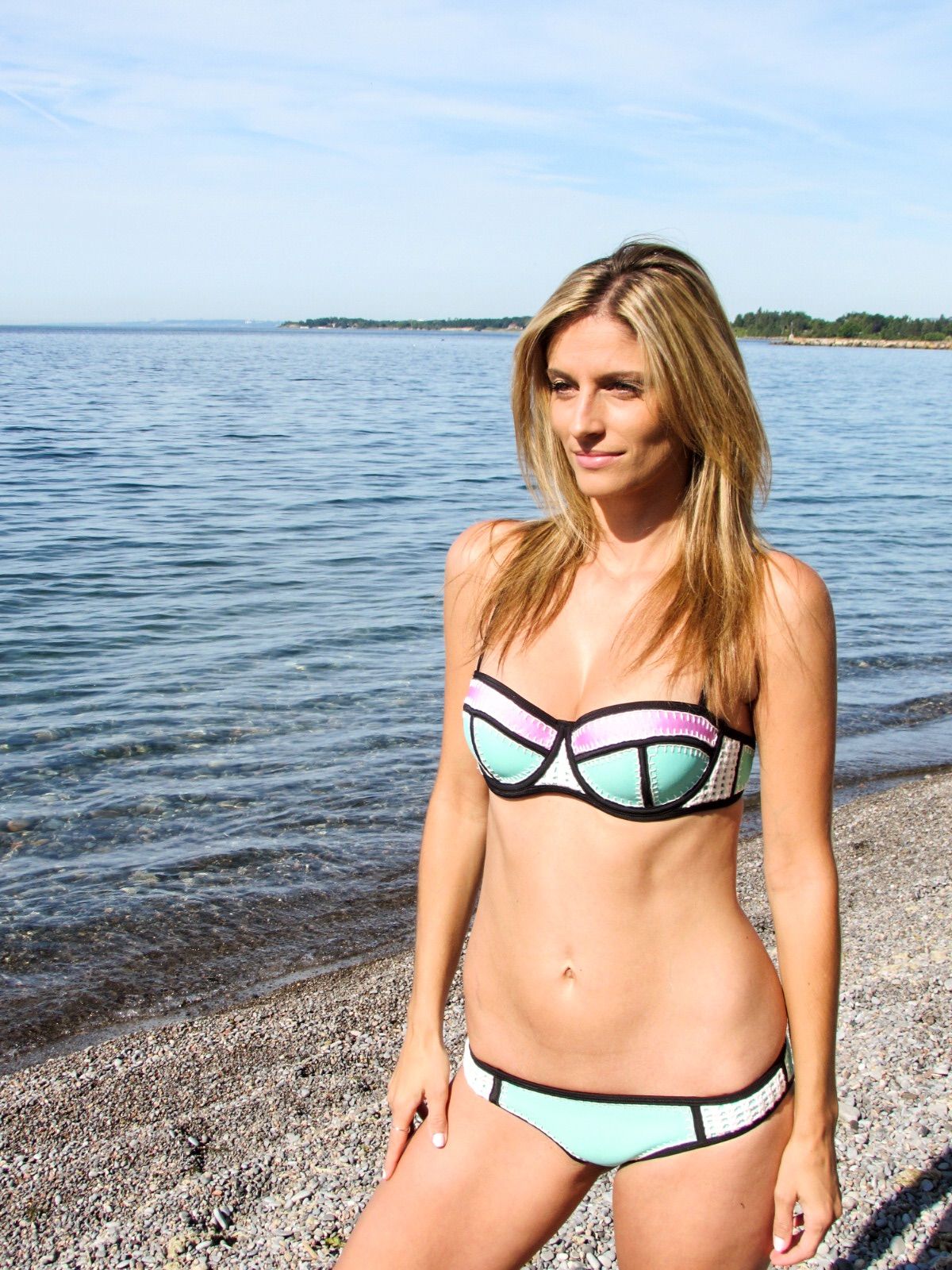Content Menu
● Understanding Sustainable Swimwear
● Triangl's Approach to Sustainability
● Comparing Triangl to Sustainable Swimwear Brands
● The Importance of Transparency
● The Consumer's Role in Sustainable Fashion
● The Future of Sustainable Swimwear
● Conclusion
● Video Resources
● Frequently Asked Questions
>> 1. Q: What materials does Triangl use for their swimwear?
>> 2. Q: Does Triangl have any sustainability certifications?
>> 3. Q: How does Triangl's packaging compare to sustainable brands?
>> 4. Q: Are there any known recycling programs for Triangl swimwear?
>> 5. Q: How transparent is Triangl about their manufacturing processes?
In recent years, sustainability has become a crucial factor in consumer decision-making, especially in the fashion industry. As more people become aware of the environmental impact of their clothing choices, brands are under increasing pressure to adopt eco-friendly practices. One brand that has garnered attention in the swimwear market is Triangl. Known for its vibrant colors and distinctive designs, Triangl has made waves in the fashion world. But the question on many consumers' minds is: Is Triangl swimwear sustainable?
Article: Is Triangl Swimwear Ethical?
To answer this question, we need to delve into various aspects of sustainability in the fashion industry, examine Triangl's practices, and compare them to industry standards. Let's explore the world of sustainable swimwear and see where Triangl fits in this landscape.

Understanding Sustainable Swimwear
Before we can assess Triangl's sustainability credentials, it's essential to understand what makes swimwear sustainable. Sustainable swimwear typically encompasses several key factors:
1. Materials: Sustainable swimwear often uses recycled or eco-friendly materials, such as recycled polyester made from plastic bottles or regenerated nylon from fishing nets.
2. Production Process: Ethical manufacturing practices, including fair labor conditions and reduced water and energy consumption, are crucial components of sustainable production.
3. Durability: High-quality, long-lasting swimwear that can withstand multiple seasons reduces the need for frequent replacements, thus minimizing waste.
4. Packaging: Eco-friendly packaging made from recycled or biodegradable materials is another important aspect of sustainability.
5. End-of-Life Considerations: Some sustainable brands offer take-back programs or design their products to be easily recyclable at the end of their lifecycle.

Triangl's Approach to Sustainability
Triangl, founded in 2012, quickly gained popularity for its neoprene bikinis and bold color combinations. While the brand has been successful in terms of style and marketing, information about its sustainability practices is somewhat limited. Let's examine what we know about Triangl's approach to sustainability:
Materials:
Triangl initially made its name with neoprene swimwear, a synthetic rubber material. While neoprene is durable, it's not typically considered an eco-friendly option. In recent years, the brand has expanded its range to include other fabrics, but detailed information about the sustainability of these materials is not readily available on their website.
Production Process:
Information about Triangl's manufacturing processes and labor practices is limited. The brand produces its swimwear in China, but details about factory conditions, worker welfare, and environmental impact of production are not publicly disclosed.
Durability:
Many customers praise Triangl swimwear for its quality and durability. Long-lasting swimwear can be considered more sustainable as it reduces the need for frequent replacements. However, this alone does not make a brand sustainable if other eco-friendly practices are not in place.
Packaging:
Triangl provides its swimwear in reusable neoprene bags, which can be seen as a step towards sustainability. However, the overall packaging strategy and its environmental impact are not clearly communicated.
End-of-Life Considerations:
There is no publicly available information about Triangl offering a recycling program or providing guidance on how to responsibly dispose of their swimwear at the end of its life cycle.

Comparing Triangl to Sustainable Swimwear Brands
To better understand Triangl's position in the sustainable swimwear market, it's helpful to compare it to brands that are known for their eco-friendly practices. Many sustainable swimwear brands have emerged in recent years, setting new standards for environmental responsibility in the industry.
These brands often use materials like ECONYL, a regenerated nylon made from ocean waste, or recycled polyester. They are transparent about their supply chains, manufacturing processes, and the environmental impact of their products. Some even go as far as to obtain certifications from recognized sustainability organizations.
In contrast, Triangl's approach to sustainability appears to be less comprehensive and transparent. While the brand may have some sustainable practices, the lack of clear communication about these efforts makes it difficult for consumers to make informed decisions about the environmental impact of their purchases.
The Importance of Transparency
One of the key issues when assessing Triangl's sustainability is the lack of transparency. In today's market, consumers increasingly expect brands to be open about their practices, from sourcing materials to manufacturing processes. Many sustainable brands provide detailed information about their supply chains, environmental initiatives, and social responsibility efforts.
Triangl's website and public communications offer limited information about their sustainability practices. This lack of transparency makes it challenging for environmentally conscious consumers to determine whether Triangl aligns with their values.

The Consumer's Role in Sustainable Fashion
While brands bear significant responsibility for their environmental impact, consumers also play a crucial role in driving sustainability in the fashion industry. Here are some ways consumers can make more sustainable choices when it comes to swimwear:
1. Research brands: Look for brands that are transparent about their sustainability practices and use eco-friendly materials.
2. Prioritize quality: Invest in high-quality swimwear that will last for multiple seasons, reducing the need for frequent replacements.
3. Care for your swimwear: Proper care can extend the life of your swimwear. Rinse after use, avoid harsh detergents, and air dry to maintain the quality of the fabric.
4. Consider second-hand options: Buying pre-owned swimwear can be a sustainable choice, reducing demand for new production.
5. Look for certifications: Some sustainable brands have certifications from organizations like Global Organic Textile Standard (GOTS) or OEKO-TEX, which can provide assurance of eco-friendly practices.
The Future of Sustainable Swimwear
As consumer awareness grows and technology advances, the future of sustainable swimwear looks promising. Innovations in fabric technology are leading to more eco-friendly materials that perform well in water and maintain their shape and color. Some brands are experimenting with biodegradable swimwear, while others are developing closed-loop systems to recycle old swimwear into new products.
For brands like Triangl to remain competitive in this evolving market, they may need to adapt their practices and increase transparency about their sustainability efforts. Consumers are increasingly looking for brands that align with their values, and sustainability is becoming a key factor in purchasing decisions.

Conclusion
While Triangl has made a name for itself in the swimwear industry with its bold designs and quality products, its sustainability credentials remain unclear. The lack of transparent information about materials, production processes, and environmental initiatives makes it difficult to definitively answer whether Triangl swimwear is sustainable.
For consumers who prioritize sustainability, there are many other brands in the market that offer more clarity about their eco-friendly practices. However, it's important to note that sustainability is a journey, and brands can improve their practices over time. As consumer demand for sustainable fashion continues to grow, we may see more brands, including Triangl, increase their focus on environmental responsibility and transparency.
Ultimately, the choice of whether to purchase from Triangl or other swimwear brands depends on individual priorities and values. Consumers who are passionate about sustainability may want to seek out brands with clearer eco-credentials, while those who prioritize Triangl's style and fit may choose to support the brand while encouraging them to adopt more sustainable practices.
As we move forward, it's crucial for both brands and consumers to recognize the importance of sustainability in fashion. By making informed choices and supporting brands that prioritize environmental responsibility, we can all contribute to a more sustainable future for the fashion industry.

Video Resources
1. TRIANGL BIKINIS HONEST REVIEW. Sizing, quality, price.
2. 2022 Triangl Bikinis try on haul | Unsponsored honest review
3. Sustainable Swimwear | Testing Ethical Basics
Frequently Asked Questions
1. Q: What materials does Triangl use for their swimwear?
A: Triangl initially gained popularity for their neoprene bikinis. They have since expanded their range to include other fabrics, but detailed information about the sustainability of these materials is not readily available on their website.
2. Q: Does Triangl have any sustainability certifications?
A: There is no public information about Triangl holding any specific sustainability certifications. Many eco-friendly brands obtain certifications from organizations like Global Organic Textile Standard (GOTS) or OEKO-TEX, but Triangl does not appear to have these.
3. Q: How does Triangl's packaging compare to sustainable brands?
A: Triangl provides their swimwear in reusable neoprene bags, which can be seen as a step towards sustainability. However, many sustainable brands go further by using recycled or biodegradable packaging materials for all aspects of their packaging.
4. Q: Are there any known recycling programs for Triangl swimwear?
A: Currently, there is no publicly available information about Triangl offering a recycling program or providing guidance on how to responsibly dispose of their swimwear at the end of its lifecycle. Some sustainable swimwear brands do offer take-back programs for recycling old swimwear.
5. Q: How transparent is Triangl about their manufacturing processes?
A: Triangl provides limited information about their manufacturing processes and labor practices. The brand produces its swimwear in China, but details about factory conditions, worker welfare, and environmental impact of production are not publicly disclosed. This lack of transparency makes it difficult for consumers to fully assess the brand's sustainability efforts.





































































